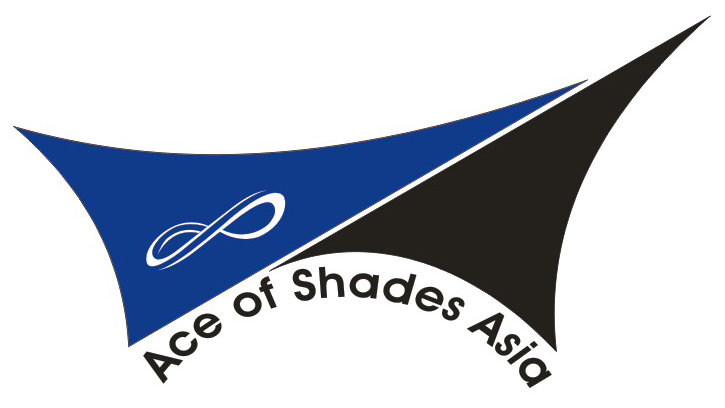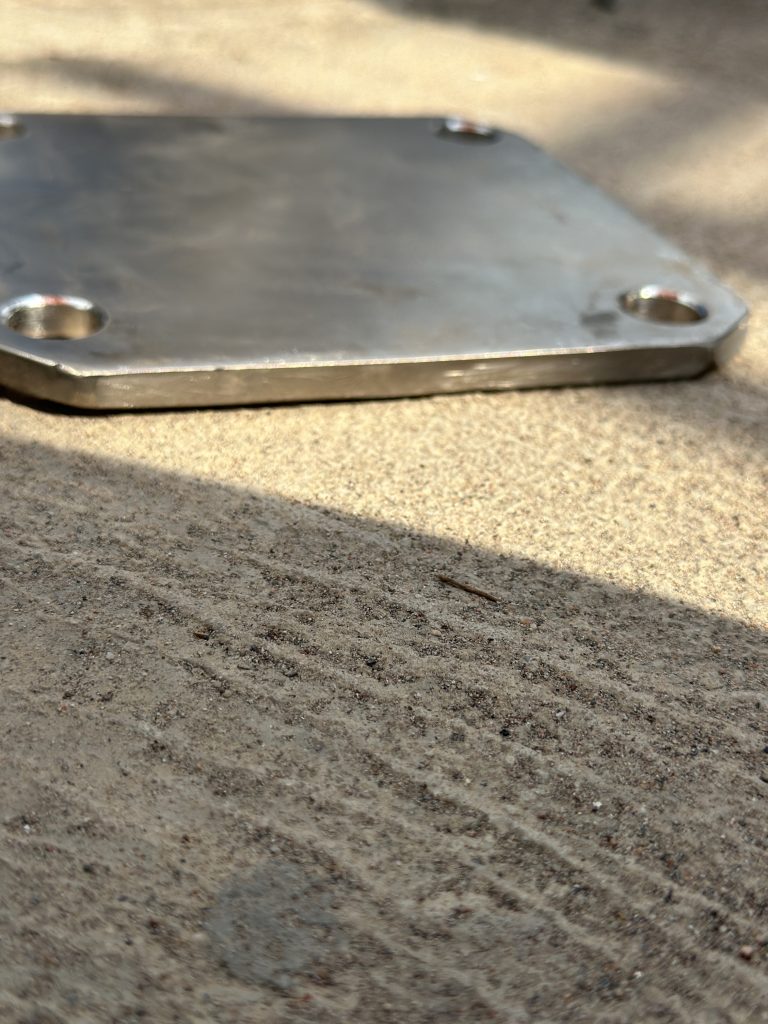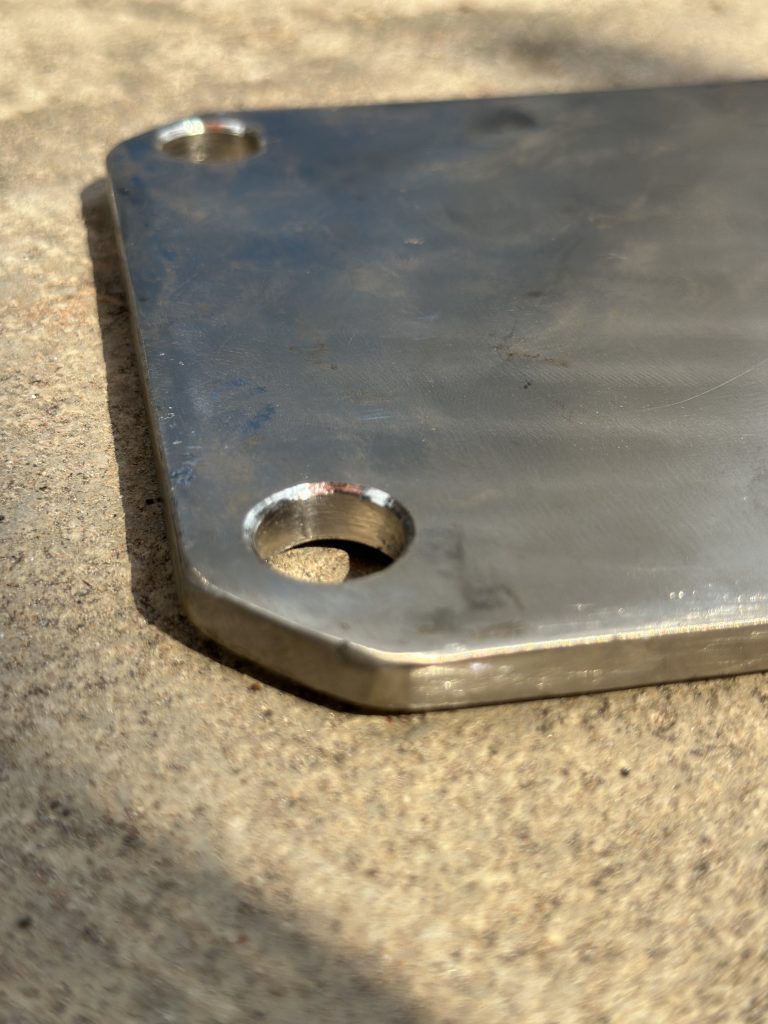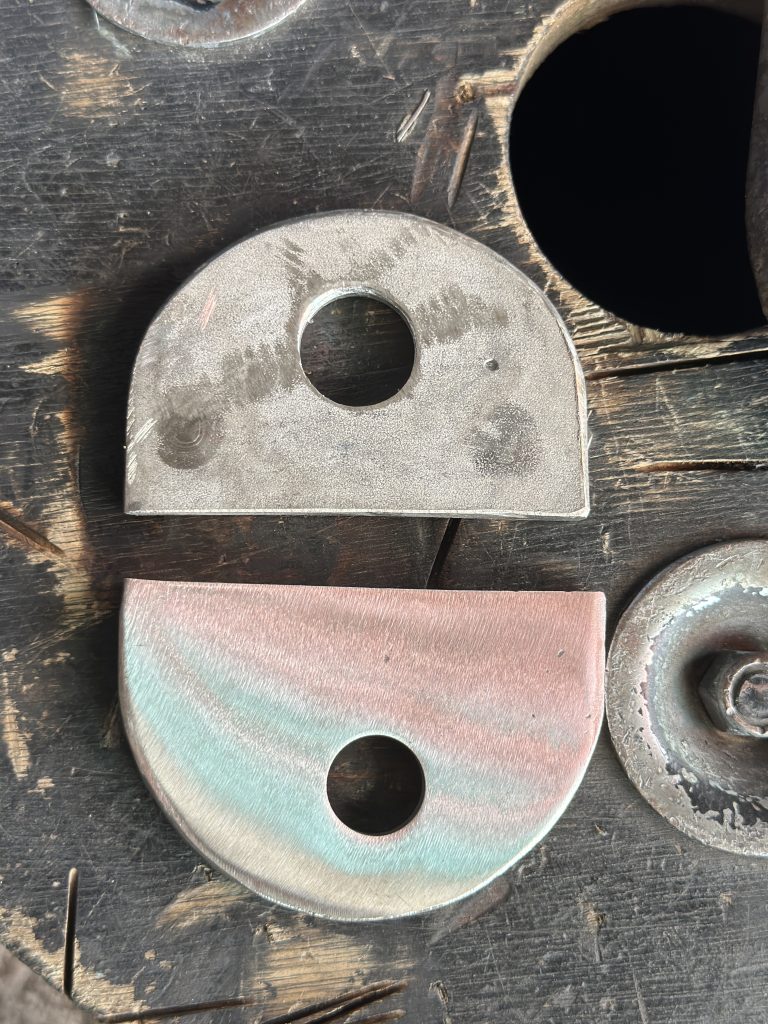Post / Pole for Shade Sails, roof structure and Tension Membrane
For Shade Sail, roof structure and Tension Membrane posts in Thailand, Laos, Cambodia, considering the tropical climate, we would like to explain the attribute of steel, galvanized steel, and stainless steel we used:
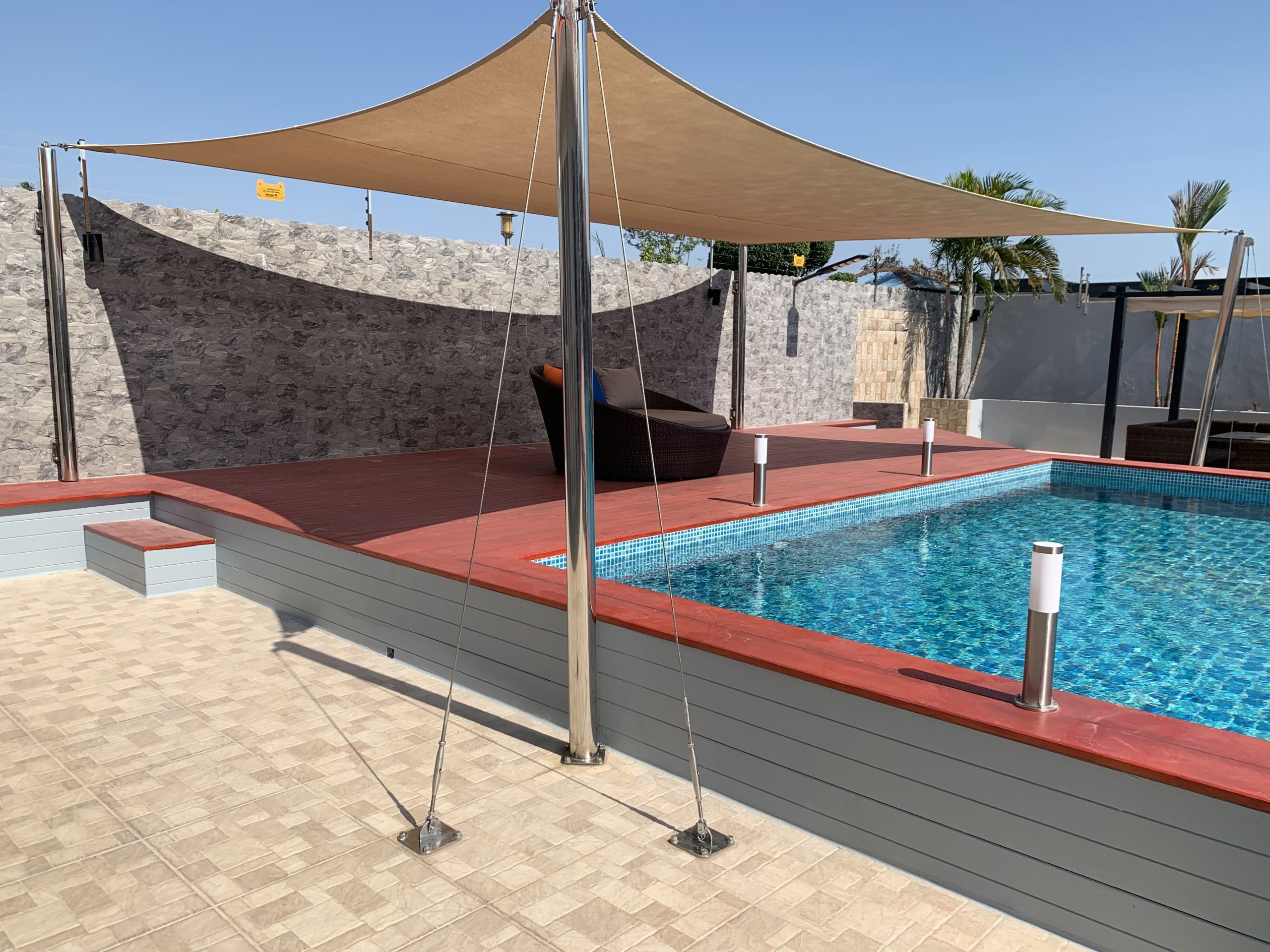
1. Steel Posts (Carbon Steel):
Steel posts offer several advantages for shade sails, Roof Structure and tension membrane installations, making them a popular choice despite the corrosion considerations in climates in Thailand, Laos and Cambodia:
1.1 High Strength and Load-Bearing Capacity:
Steel, especially structural steel, possesses exceptional tensile and compressive strength. This is crucial for supporting the significant tension forces exerted by the stretched membrane, as well as dealing with wind loads and other environmental factors.
Steel posts can handle large spans and complex membrane designs that might be challenging for materials with lower strength.
1.2 Design Flexibility and High Strength:
Provides excellent structural support for tensioned membranes. Steel is a highly versatile material that can be easily shaped, welded, and fabricated into various forms and sizes. This allows architects and engineers greater freedom in designing aesthetically pleasing and structurally efficient support systems for tension membranes.
It can be formed into slender columns, graceful arches, or more complex geometric structures, complementing the flowing lines of the membrane.
1.3 Relatively Lightweight (for its strength):
Compared to concrete posts with similar load-bearing capacity, steel is significantly lighter. This can lead to:
Easier transportation and handling on-site, especially in locations with limited access.
Reduced loads on the foundations, potentially leading to smaller and more cost-effective foundation designs.
Faster erection times, as steel components can be prefabricated off-site and quickly assembled.
1.4 Durability (with proper treatment):
While carbon steel is susceptible to corrosion, effective protective measures like galvanizing or the use of high-quality coatings can significantly enhance its durability and lifespan, making it a viable option even in Asia ‘s humidity.
Stainless steel posts offer the ultimate durability and corrosion resistance, making them ideal for long-term, low-maintenance installations, although with a higher initial cost.
1.5 Integration with Other Steel Components:
Tension membrane structures often involve a network of steel cables, tensioning hardware, and edge beams. Using steel posts allows for seamless and strong connections between these various structural elements through welding, bolting, or other mechanical means.
1.6 Cost-Effectiveness (in some cases):
While stainless steel has a higher upfront cost, carbon steel posts with appropriate protective coatings can be a more economical choice for projects with budget constraints, provided that a regular maintenance schedule for corrosion protection is factored in.
1.7 Sustainability (Recyclability):
Steel is a highly recyclable material. At the end of the structure’s life, the steel posts can be reused or recycled, contributing to sustainable building practices.
While the humidity and potential for coastal salt air necessitate careful consideration of corrosion protection, the inherent strength and design flexibility of steel posts often make them the preferred choice for tension membrane structures. The decision between carbon steel (with robust galvanization or coatings) and stainless steel will depend on the project’s budget, lifespan requirements, and proximity to the sea. Stainless steel offers the best long-term performance with minimal maintenance in this environment.
2. Galvanized Steel Posts:
Galvanized steel posts offer a valuable middle ground for Shade Sail, Roof Structure, and tension membrane installations, providing several advantages over plain steel while often being more cost-effective than stainless steel:
2.1 Enhanced Corrosion Resistance:
The primary advantage of galvanizing is its significantly improved resistance to rust and corrosion compared to untreated carbon steel. The zinc coating acts as a sacrificial anode, meaning it will corrode before the underlying steel is affected. This is particularly beneficial in Bangkok’s humid climate, which accelerates the corrosion of unprotected steel.
Studies on galvanized steel in Thailand, Laos and Cambodia ‘s tropical climate show that while corrosion does occur, the rate is considerably slower than that of carbon steel. The lifespan of the zinc coating depends on the environment, with coastal and industrial areas generally experiencing a higher corrosion rate than rural areas.
2.2 Good Strength and Durability:
Galvanizing does not significantly compromise the strength of the steel. Galvanized steel posts retain the high load-bearing capacity necessary for supporting tensioned membranes and withstanding wind loads.
The zinc coating also provides a degree of protection against mechanical damage during handling and installation.
2.3 Cost-Effective Alternative:
Galvanized steel typically has a lower initial cost compared to stainless steel, making it an attractive option for projects with budget limitations. While it may not offer the same level of long-term corrosion resistance as stainless steel, it provides a substantial improvement over plain steel at a reasonable price.
2.4 Reduced Maintenance:
Compared to untreated steel that requires regular painting and rust removal, galvanized steel requires significantly less maintenance. The zinc coating can provide years of protection with minimal intervention. However, periodic inspection for damage to the coating is still recommended, especially in aggressive environments.
2.5 Predictable Performance:
The corrosion rate of galvanized steel is relatively predictable, allowing for estimations of the posts’ lifespan based on the environmental conditions and the thickness of the zinc coating.
However, it’s important to consider the following limitations in the context of Asia’s climate:
Lifespan: While galvanized steel offers good corrosion resistance, its lifespan will be shorter than that of stainless steel, especially in coastal areas with high salt content in the air. Research indicates that in coastal/urban areas of Thailand and Cambodia, the corrosion rate of galvanized steel is higher than in rural areas.
Maintenance: Although less than ungalvanized steel, the zinc coating can eventually degrade, and maintenance such as touch-up coatings may be necessary to extend the lifespan of the posts.
In conclusion, galvanized steel posts offer a good balance of strength, corrosion resistance, and cost-effectiveness for tension membrane installations in Thailand, Laos and Cambodia. They are a significant improvement over plain steel and can provide a long service life with appropriate consideration of the environmental conditions and occasional maintenance. However, for projects prioritizing the longest possible lifespan with minimal maintenance, especially in coastal locations, stainless steel remains the superior choice.
3. Stainless Steel Posts (Grade 304 or 316):
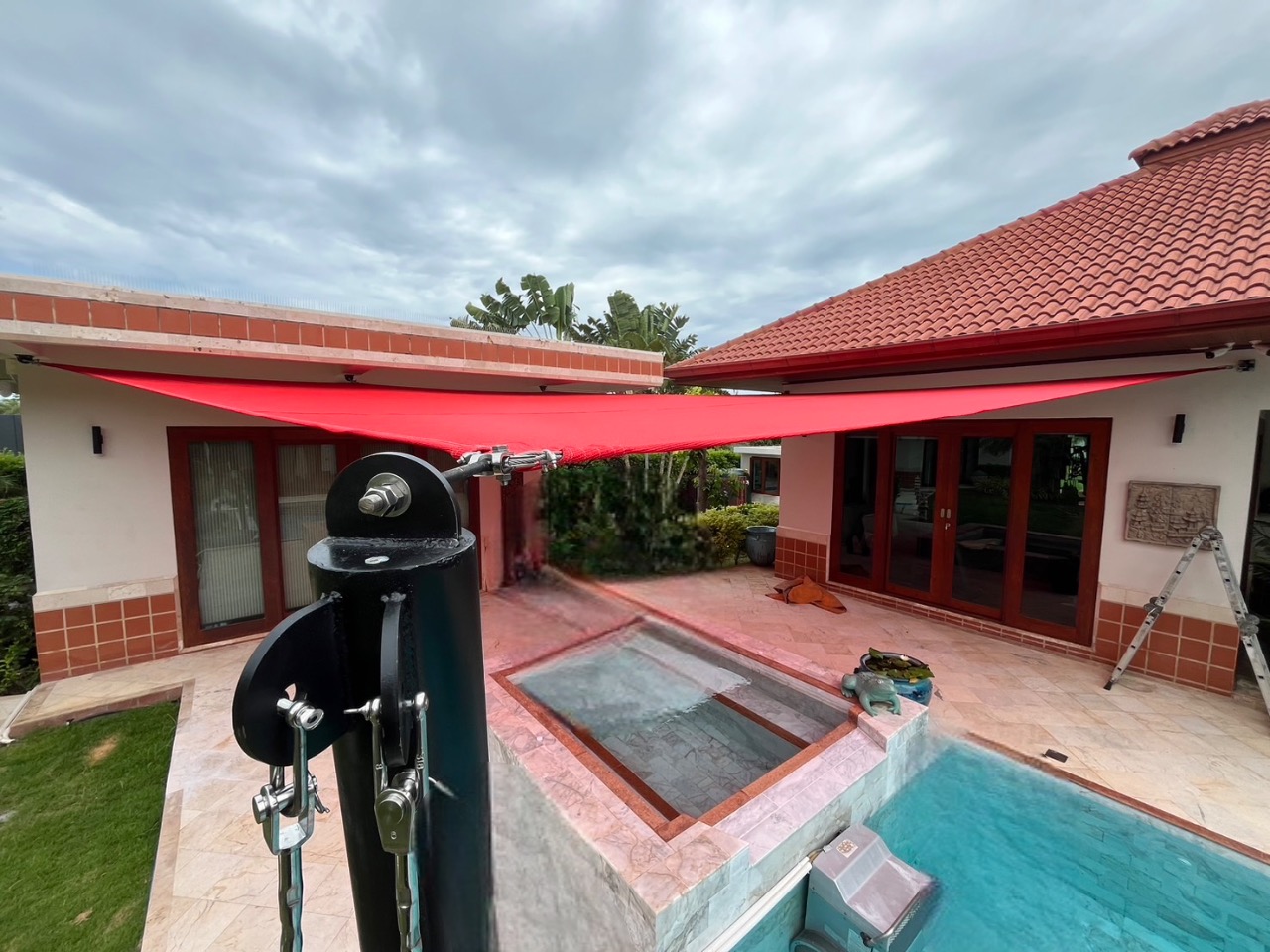
- Superior Corrosion Resistance: Offers the best protection against rust and degradation, ideal for Asia ‘s humid and potentially salty air. Grade 316 stainless steel for maximum corrosion resistance provides even greater resistance, especially in coastal locations.
- High Strength and Durability: Ensures a long-lasting and structurally sound support system for the tension membrane.
- Low Maintenance: Requires minimal maintenance due to its inherent corrosion resistance. A simple wash is usually sufficient.
- Aesthetics: Offers a clean, modern, and often polished appearance. Consider the desired aesthetic appearance of the posts.
For Shade Sail, tension membrane installations, particularly in a climate like Pattaya, Hua Hin,Koh Samui, Koh Tao, Southern of Thailand, stainless steel posts offer several compelling advantages that often outweigh their higher initial cost:
3.1 Superior Corrosion Resistance:
This is the most significant advantage. Stainless steel, especially grades 304 and 316, exhibits exceptional resistance to rust and corrosion. Thailand’s high humidity, frequent rainfall, and potential for coastal salt air create a corrosive environment where other steels can degrade over time. Stainless steel maintains its structural integrity and aesthetic appeal with minimal degradation.
Research on the corrosion of metals in Thailand, Laos and Cambodia confirms that stainless steel performs exceptionally well in tropical marine and urban industrial environments compared to carbon steel and even galvanized steel.
3.2 Minimal Maintenance:
Due to its inherent corrosion resistance, stainless steel requires very little maintenance. Unlike carbon steel that needs regular painting or coatings, or galvanized steel that may require touch-ups, stainless steel typically only needs occasional cleaning to maintain its appearance. This translates to significant long-term cost savings and reduced hassle.
3.3 Long Lifespan:
The superior corrosion resistance directly contributes to a significantly longer lifespan for stainless steel posts compared to other steel types in Asia’s climate. This ensures the long-term stability and safety of Shades Sail and the tension membrane structure, making it a durable and reliable investment.
3.4 High Strength and Durability:
Stainless steel possesses excellent tensile strength and durability, providing robust support for the Shade Sail and tensioned membrane and withstanding wind loads and other environmental stresses. This ensures the structural integrity of the entire installation.
3.5 Aesthetic Appeal:
Stainless steel offers a clean, modern, and often polished aesthetic that can enhance the visual appeal of the tension membrane structure. It maintains its attractive appearance over time with minimal effort.
3.6 Resistance to Staining and Discoloration:
Unlike some other metals, stainless steel is highly resistant to staining and discoloration caused by environmental factors, further contributing to its long-term aesthetic appeal.
3.7 Hygienic Properties:
Stainless steel is non-porous and easy to clean, making it a hygienic material. While not always a primary concern for structural posts, it can be a benefit in certain applications.
3.8 Recyclability:
Stainless steel is 100% recyclable without losing its properties, making it a sustainable material choice.
The hot and humid climate, coupled with the proximity to the sea for many parts of Thailand such as Sriracha, Pattaya, Jomthien, Bangsare, Bang Amphoe, Rayong,Chantaburi, Trad , Hua Hin, Southern region province Area makes stainless steel an ideal material for Shade Sail and Tension Membrane posts. The reduced maintenance and extended lifespan due to its superior corrosion resistance often justify the higher initial cost over the long term. Choosing the appropriate grade of stainless steel (304 for general applications, 316 for coastal areas with higher salt exposure) will further enhance its performance and longevity.
While galvanized steel offers improved corrosion resistance over carbon steel, it will still be susceptible to degradation over time in Asia’s environment and will require more maintenance than stainless steel.
In conclusion, the advantages of using stainless steel posts for shade Sail, Tension membrane installations in Pattaya, Hua Hin, Koh tao, Koh Samui, coastal area around their exceptional corrosion resistance, minimal maintenance requirements, long lifespan, and aesthetic appeal, making them a reliable and cost-effective solution in the long run.
